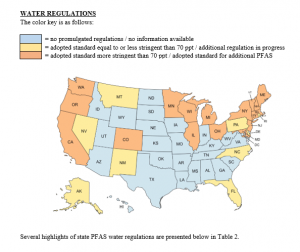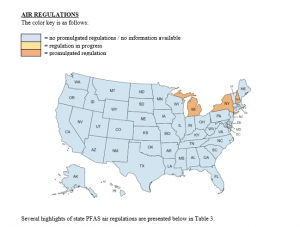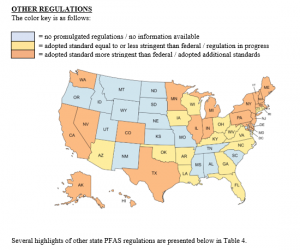PFAS: State-by-State Regulatory Update (July 2022 Revision)
Posted: July 28th, 2022
Authors: Kayla N.
Given the current lack of all-encompassing federal environmental regulation around per- and polyfluoroalkyl substances (PFAS), states are taking it upon themselves to set their own standards amid growing public scrutiny. With proposed house bills, rejections of bills, and other PFAS news popping up seemingly every day, it can be difficult to keep track of the regulatory climate and obligations. ALL4 is here to help.
Note: This information is current as of July 28, 2022.
First to level-set, several key PFAS regulations currently at the federal level are presented below in Table 1.
Table 1
|
||
| Category | Subcategory | Regulation |
| Water | Drinking Water
|
Health Advisory Level (HAL) of 0.004 parts per trillion (ppt) for perfluorooctanoic acid (PFOA), 0.02 ppt for perfluorooctane sulfonate (PFOS), 10 ppt for hexafluoropropylene oxide (HFPO) dimer acid and its ammonium salt (together referred to as ‘‘GenX chemicals’’), and 2,000 ppt for perfluorobutane sulfonic acid and its related compound potassium perfluorobutane sulfonate (PFBS).
Note: HALs are not enforceable. U.S. Environmental Protection Agency (U.S. EPA) is moving forward to implement enforceable drinking water maximum contaminant levels (MCLs) for PFOA and PFOS. U.S. EPA is also evaluating additional PFAS beyond PFOA and PFOS and considering actions to address groups of PFAS. The proposed MCLs are anticipated in Fall 2022, but an enforceable limit does not exist at this time. |
| Published the final fifth Unregulated Contaminant Monitoring Rule (UCMR 5) which will require sample collection for 29 PFAS between 2023 and 2025. | ||
| National Pollutant Discharge Elimination System (NPDES) | U.S. EPA issued a memo to agency water program directors which details how the U.S. EPA will address PFAS discharges in EPA-issued NPDES permits and provides recommended PFAS-related permit language. | |
| Air | N/A | There are no proposed or promulgated standards at this time. |
| Other | Toxic Release Inventory (TRI) | Section 7321 of the National Defense Authorization Act for Fiscal Year 2020 (NDAA), which was passed in December 2019, immediately added 172 PFAS to the list of chemicals covered by the TRI and provided a framework for additional PFAS to be added to TRI on an annual basis. This list became effective January 1, 2020, with the first PFAS Form Rs required by July 1, 2021. Eight additional PFAS have been added to the TRI list since then, bringing the current total to 180. |
| Aqueous Film Forming Foam (AFFF) | The Department of Defense (DOD) is phasing out AFFF and prohibits the use of AFFF during training exercises at military sites. | |
| Comprehensive Environmental Response, Compensation, and Liability Act (CERCLA) | Added Regional Screening Levels (RSL) for PFBS, GenX chemicals, PFOS, PFOA, perfluorononanoic acid (PFNA), and perfluorohexane sulfonic acid (PFHxS) for Superfund sites. Note that RSLs are general screening levels, not cleanup standards.
Additionally, U.S. EPA has restarted the process of proposing to designate PFOA and PFOS as “hazardous substances”. |
|
| Resource Conservation and Recovery Act (RCRA) | Initiated the process to propose adding PFOA, PFOS, PFBS, and GenX chemicals as “hazardous constituents” under Appendix VIII. Additionally, proposed clarification that the RCRA Corrective Action Program has the authority to require investigation and cleanup for wastes that meet the statutory definition of hazardous waste, as defined under RCRA §1004(5). | |
| Toxic Substances Control Act (TSCA) | Proposed rule requiring all manufacturers (including importers) of PFAS in any year since 2011 to report information related to chemical identity, categories of use, volumes manufactured and processed, byproducts, environmental and health effects, worker exposure, and disposal. | |
| Significant New Use Rule (SNUR) | Finalized for PFOA and PFOA-related chemicals. The SNUR requires notification from anyone who begins or resumes the manufacturing, including importing, or processing of these chemicals. The SNUR addresses risks from products like carpets, furniture, electronics, and household appliances. | |
The following maps provide a high-level summary of what states are currently doing in terms of water, air, and other (e.g., AFFF, waste, consumer goods, remediation) PFAS-related regulations. This does not include any litigation, consent decrees, action plans/task forces, or investigative sampling.
Table 2
|
||
| State | Water Regulation Subcategory | Regulation |
| California | Drinking Water Notification Levels | PFOS (6.5 ppt), PFOA (5.1 ppt), and PFBS (500 ppt)
Note: The State Water Board has also requested notification levels for perfluorohexane sulfonic acid (PFHxS), perfluorohexanoic acid (PFHxA), perfluoroheptanoic acid (PFHpA), perfluorononanoic acid (PFNA), perfluorodecanoic acid (PFDA), and 4,8-dioxia-3H-perflourononanoic acid (ADONA). |
| Drinking Water Response Levels | PFOS (40 ppt), PFOA (10 ppt), and PFBS (5,000 ppt) | |
| Colorado | Surface Water/Groundwater Translation Levels | PFOA + PFOS + PFNA (70 ppt, combined), PFHxS (700 ppt), and PFBS (400,000 ppt)
Note: The policy also includes monitoring and permitting considerations for entities that discharge to state waters. |
| Connecticut | Drinking Water Action Levels | PFOA (16 ppt), PFOS (10 ppt), PFNA (12 ppt), and PFHxS (49 ppt) |
| Delaware | Proposed Drinking Water MCLs | PFOS (14 ppt), PFOA (21 ppt), and PFOS + PFOA (17 ppt, combined). |
| Illinois | Drinking Water Health Advisories | PFBS (2,100 ppt), PFHxS (140 ppt), PFOS (14 ppt), PFOA (2 ppt), PFNA (21 ppt), and PFHxA (560,000 ppt).
Note: Illinois is also in the process of introducing groundwater quality standards and evaluating the need to introduce drinking water MCLs for several PFAS. |
| Maine | Interim Drinking Water MCLs | PFOS, PFOA, PFHpA, PFNA, PFHxS, and PFDA (20 ppt, combined)
Note: Maine also has monitoring requirements for PFAS. |
| Maryland | Drinking Water Health Advisories | PFHxS (140 ppt) |
| Massachusetts | Drinking Water MCLs | PFOS, PFOA, PFHxS, PFNA, PFHpA, and PFDA (20 ppt, combined) |
| Michigan | Drinking Water MCLs | PFNA (6 ppt), PFOA (8 ppt), PFHxA (400,000 ppt), PFOS (16 ppt), PFHxS (51 ppt), PFBS (420 ppt), and hexafluoropropylene oxide dimer acid (HFPO-DA) (370 ppt) |
| Minnesota | Drinking Water Health Advisories | PFOS (15 ppt), PFOA (35 ppt), PFHxS (47 ppt), PFBS (2,000 ppt), and PFBA (7,000 ppt) |
| New Hampshire | Drinking Water MCLs and Ambient Groundwater Quality Standards (AGQS) | PFOA (12 ppt), PFOS (15 ppt), PFNA (11 ppt), and PFHxS (18 ppt) |
| New Jersey | Drinking Water MCLs | PFNA (13 ppt), PFOA (14 ppt), and PFOS (13 ppt) |
| Groundwater Quality Standards (GWQS) | PFNA (13 ppt), PFOA (14 ppt), PFOS (13 ppt), and chloroperfluoropolyether carboxylates (ClPFPECAs) (2,000 ppt, interim limit) | |
| New York | Drinking Water MCLs | PFOA (10 ppt) and PFOS (10 ppt) |
| North Carolina | Drinking Water Health Goal | GenX (140 ppt)
Note: This health goal has now been superseded by U.S. EPA’s health advisory of 10 ppt. |
| Proposed GWQS | PFOA and PFOS (70 ppt, combined). | |
| Ohio | Drinking Water Action Levels | PFOA and PFOS (70 ppt, combined), GenX (700 ppt), PFBS (140,000 ppt), PFHxS (140 ppt), and PFNA (21 ppt) |
| Oregon | Drinking Water Health Advisories | PFOA, PFOS, PFHxS, and PFNA (30 ppt, combined) |
| Pennsylvania | Proposed Drinking Water MCLs | PFOA (14 ppt) and PFOS (18 ppt) |
| Rhode Island | Proposed Drinking Water MCLs | PFOA, PFOS, PFDA, PFNA, PFHxS, and PFHpA (20 ppt, combined) |
| Vermont | Drinking Water MCLs | PFOS, PFOA, PFHxS, PFNA, and PFHpA (20 ppt, combined) |
| Washington | Drinking Water State Action Levels (SALs) | PFOA (10 ppt), PFOS (15 ppt), PFNA (9 ppt), PFHxS (65 ppt), and PFBS (345 ppt) |
| Wisconsin | Drinking Water MCLs | PFOA and PFOS (70 ppt; rule effective August 1, 2022) |
| Surface Water Standards | PFOS (8 ppt) and PFOA (20 ppt for public water supplies, 95 ppt for all other surface water). | |
Table 3
|
||
| State | Air Regulation Subcategory | Regulation |
| Michigan | Air Toxics | Allowable concentration levels (ACLs) set for PFOA and PFOS of 0.07 micrograms per cubic meter (µg/m³), 24-hour average, individually or combined. New or modified sources that are required to obtain an air use permit are subject to Michigan’s air toxics rules, unless otherwise exempt. |
| New Hampshire | Air Toxics | Ambient air limits (AAL) set for ammonium perfluorooctanoate (APFO) of 0.05 µg/m³ (24-hour) and 0.024 µg/m³ (annual). New, modified, and existing processes are subject to the air toxics rule. |
| Best Available Control Technology (BACT) | BACT requirement for any facility that may cause or contribute to an AGQS or surface water quality standard (SWQS) exceedance of perfluorinated compounds (PFCs) or precursors, which includes certain PFAS. | |
| New York | Air Toxics | Annual guideline concentration (AGC) set for PFOA of 0.0053 µg/m3. Any facility regulated under Part 212 must evaluate air contaminants, including PFOA, as applicable. |
Table 4
|
||
| State | Other Regulation Subcategory | Regulation |
| Alaska | AFFF/Hazardous Designation | Classified certain PFAS materials found in AFFF as “hazardous substances,” requiring notification and reporting. |
| Remediation | Soil and groundwater cleanup levels for PFOS and PFOA. | |
| California | AFFF | Reporting, notification, usage, and manufacturer requirements. |
| Consumer Goods | Restrictions on PFOA or PFOS-containing cosmetics, PFAS-containing food packaging, and PFAS-containing carpets and rugs that are manufactured in or imported to California. | |
| Personal Protective Equipment (PPE) | Notification requirements for PFAS-containing PPE. | |
| Proposition 65 | Warning required for PFOA, PFOS, and PFNA. | |
| Colorado | AFFF | Usage and registration requirements for Class B firefighting foams. |
| PPE | Seller notification requirements for PFAS-containing PPE. | |
| Hazardous Designation | PFOA and PFOS added as “hazardous constituents” by the Solid and Hazardous Waste Commission. | |
| Delaware | AFFF | Proposed reporting, notification, and usage requirements. |
| Hazardous Designation | Policy adopted which classifies PFOA and PFOS as “hazardous substances.” | |
| Hawaii | Remediation | Interim soil and groundwater Environmental Action Levels (EALs) for certain PFAS. |
| Illinois | AFFF | Usage and manufacturer requirements. |
| Incineration | Bill to prohibit incineration of PFAS (with certain exceptions). | |
| Indiana | AFFF | Usage requirements. |
| Remediation | Screening levels for certain PFAS. | |
| Maine | AFFF | Proposed reporting, notification, and usage requirements. |
| Consumer Goods | Prohibition of PFAS-containing packaging, children’s products, carpets/rugs/fabrics, and pesticides. Prohibition of sale of any product containing PFAS that were intentionally added. | |
| Hazardous Designation | Changed definition of “hazardous substances” to include PFAS. | |
| Land Application | Prohibition of land application of sludge generated from municipal, commercial, or industrial wastewater treatment plants, compost produced from sludge, or any other materials derived from sludge. | |
| Remediation | Soil remedial action screening levels and water remedial action guidelines for PFBS, PFOS, and PFOA. | |
| Maryland | AFFF | Usage, discharge, and disposal requirements. Prohibition of intentionally added PFAS in Class B firefighting foam. |
| Consumer Goods | Prohibition of toxic flame retardants in furniture, mattress foam, and children’s products. Prohibition of intentionally added PFAS in rugs and carpets, and certain food packages and food packaging. | |
| PPE | Seller notification requirements for PFAS-containing PPE. | |
| Massachusetts | AFFF | AFFF collection and destruction program. |
| Hazardous Designation | PFAS are considered to be “hazardous material” subject to the notification, assessment and cleanup requirement. | |
| Land Application | PFAS monitoring requirements for residuals that have an Approval of Suitability (AOS) and are permitted to be reused through land application. | |
| Remediation | Established notification requirements and cleanup standards for PFAS in soil and groundwater. | |
| Michigan | AFFF | Discharge, usage, and reporting requirements. |
| Remediation | Groundwater cleanup criteria established for PFOS and PFOA. | |
| Minnesota | AFFF | Discharge and usage requirements. Prohibition of manufacturing and sale of PFAS-containing firefighting foam. |
| Consumer Goods | Prohibition of certain flame-retardant chemicals in certain types of furniture and children’s products. | |
| Nevada | AFFF/Consumer Goods | Restrictions on PFAS and additive organohalogenated flame retardants (OFR) used in textiles, children’s products, mattresses, upholstered residential furniture, and Class B firefighting foams. |
| New Hampshire | AFFF | Discharge and usage requirements. |
| PPE | Seller notification requirements for PFAS-containing PPE. | |
| New Jersey | AFFF | Proposed discharge and usage requirements. |
| Hazardous Designation | Addition of PFOA, PFOS, and PFNA to list of “hazardous substances.” | |
| New York | AFFF | Usage, notification, and incineration requirements. |
| Consumer Goods | Prohibition of PFAS additions in food packaging materials. Notification requirements for PFOS- and PFOA-containing children’s products. | |
| Hazardous Designation | PFOS and PFOA classified as hazardous substances. | |
| Pennsylvania | AFFF | Proposed discharge and use requirements. |
| Biosolids | Revised Biosolids General Permits to include PFOA and PFOS monitoring requirements (pre-draft issued). | |
| Remediation | Addition of groundwater and soil medium-specific concentration (MSC) for PFOA, PFOS, and PFBS. | |
| Texas | Remediation | Protective concentration levels (PCLs) set for 16 PFAS in groundwater and soil. |
| Vermont | AFFF | Takeback effort and proposed usage requirement. Restrictions on the use, manufacture, sale, and distribution of Class B firefighting foam containing PFAS. |
| Biosolids/Land Application | Solid waste rules that require PFAS testing for biosolids and for soils, groundwater, and crops at land application sites. | |
| Consumer Goods | Restrictions on the production, sale and distribution of food packaging to which PFAS have been intentionally added.
Restrictions on the manufacture, sale, and distribution of residential rugs and carpets to which PFAS have been intentionally added, as well as the use of after-market treatment products that contain PFAS.
Ban on the manufacture, sale and distribution of PFAS-containing ski wax, if the PFAS was intentionally added.
Inclusion of PFHxS, PFHpA, and PFNA on the list of chemicals of high concern to children. |
|
| Remediation | Groundwater/cleanup standards of PFOA, PFOS, PFHxS, PFHpA, and PFNA. | |
| Washington | AFFF | Usage, notification, and manufacturer requirements. |
| Consumer Goods | Prohibition of PFAS additions in food packaging materials. Restrictions for PFAS-containing product categories including apparel and cosmetics. | |
| PPE | Notification for PPE containing PFAS. | |
ALL4 continues to track the regulatory movements and maintains a database of current state PFAS activity. If you have any questions about a specific state or would like any additional information, please reach out to Kayla Turney at kturney@all4inc.com.




